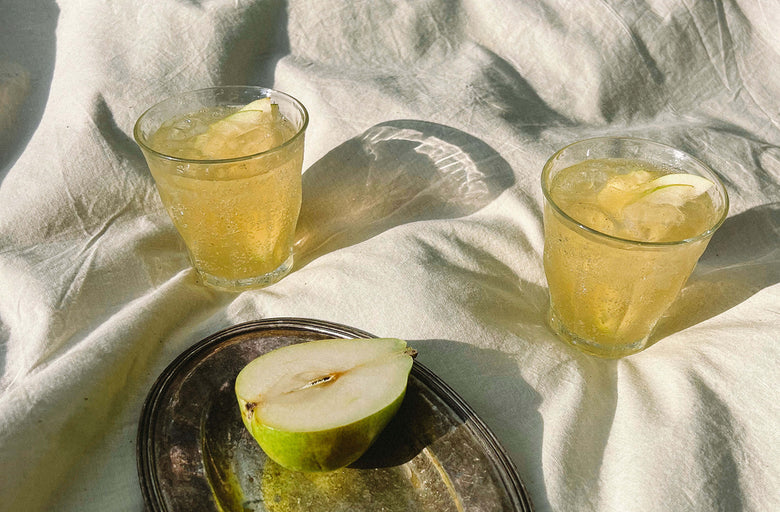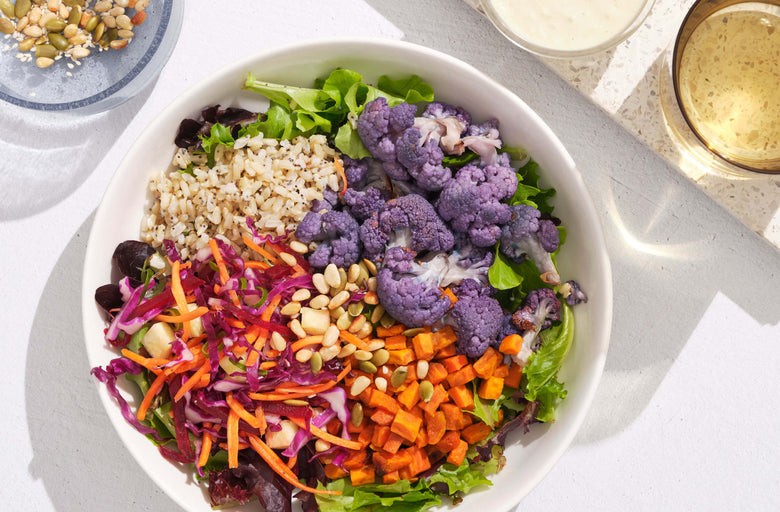Buddhist principles refer to an untamed, restless brain—one stuck on negativity and racing thoughts—as your “monkey mind.” Also known as the inner critic, the brain left unchecked will repeat negative thoughts, and bring along with it stress, fear, and worry. This doesn’t just affect your mind. Your whole body—your whole world—expands and contracts depending on the force of this scattered, redundant headspace. After a while, operating from this state can leave you physically tired and wired, and ultimately affect your digestion, blood sugar, and immunity.
Through nutrition and rituals, you can rebuild a new internal landscape and bring a loving, intentional relationship to the self. It all begins by strengthening the body’s main communication center: the nervous system.

Your Body’s Electrical Wiring
The nervous system is a complex network of nerves and cells that carry messages; they begin in the brain, then make their way down the spinal cord, dispersing all the way down to your toes. There are two parts: Central Nervous System (everything above your shoulders) and the Peripheral Nervous System (everything below). Within the PNS, there is the Autonomic Nervous System, and within this system resides one long sinewy nerve called the vagus nerve, named as it wanders through the body like a vagabond. Make no mistake, though; this nerve is intentional with its duties. Emerging research shows that it may be the link to dismantle chronic inflammation, bolster memory, and act as the kickstarter to the body’s natural relaxation response. It’s also the two-way superhighway between the gut and the brain. With these systems in constant communication, food and digestion intimately impact what was once believed only to be the brain’s business: mood, subconscious thoughts, decision-making, and even creative potential.
Nourish Your Nervous System
A weakened nervous system is hypersensitive to the lack of nature, and to the overuse and abuse of caffeine, stimulants, and mental chatter. It also employs the fight-or-flight response, which secretes cortisol (known as the stress hormone). Energetically, the nervous system acts like a protector from danger— if you place your hand on a hot stove, for example, it will send a warning by releasing cortisol to get you to act fast. Over time, though, misuse of cortisol spikes (i.e, making everything an emergency) can create a metabolic breakdown. This is when premature aging takes over, which can bring with it inflammation, thinning skin, and weight gain centralized around your organs and abdominals. Strengthening the vagus nerve activates the parasympathetic nervous system, the antithesis of this fight-or-flight response. Just look at regular meditators, who often exude a celestial, child-like radiance; their soothed nervous system reverses signs of aging.
Along with some regular healthy rituals like getting out into nature, saying no to 24/7 screen time, and integrating a breathwork or meditation habit, what you eat can have a profound effect on recalibrating the nervous system as well. There are functional foods that you can incorporate in your diet to help with stress and modulate its effects on the body. Below, we’ve provided a hot-list of flowering bodies and tonic herbs for your nutritional toolbox, to reset and rebuild a nervous system running on fumes from a wild, modern world.
food and digestion intimately impact what was once believed only to be the brain’s business: mood, subconscious thoughts, decision-making, and even creative potential.
OATSTRAW | Over time, its nutrients–– namely calcium and magnesium––rebuild an exhausted nervous system, and oatstraw is acutely calming. It's also restorative for your GI tract, as it is full of soothing mucilage, and can be used to internally cool body tissues. It tastes sweet and slightly grassy.
Found in: Citrus-Basil Vanilla Creamsicle, Oatstraw Infusion
MUCUNA PRURIENS | The closest thing to nature’s happy pill, mucuna pruriens contains L-dopa, the precursor to dopamine, the neurotransmitter that lights up the brain’s pleasure centers. It’s also been studied to relieve chronic stress-related depression and work as an aphrodisiac.
Found in: Sexy Cinnamon Rolls, Inflammation Cooling Tonic
CHAGA | Referred to as the “Diamond of the Forest,” chaga is a masterful medicinal mushroom. It takes 15 to 20 years to grow on Birch trees, where enzymes, phenols, antioxidants, superoxide dismutase, and phytonutrients become concentrated in these little flowering bodies. Chaga is especially potent in B vitamins, a class of vitamins critical for cognitive health and praised for their neuroprotective effects.
Found in: Chaga Chai Detox Bowl, Glowing Rose Adaptogenic Latte
LEMON BALM | This citrus medicine has been studied as an antidote to memory loss, a sedative for nervine disorders, and praised for its antimicrobial and antidepressant properties.
Found in: Sunshine Pops
Your whole body—your whole world—expands and contracts depending on the force of this scattered, redundant headspace.
ROSE | Beautiful, aromatic, and healing, rose is the ultimate anti-inflammatory and slippery herb. Rose hydrates the body’s membrane tissues, strengthens cellular integrity, and plumps up the skin from the inside-out. This deep hydration also supports the body’s mineral balance, which contributes to clarity and alertness. It’s also been studied to lift the mood, and nourish the pituitary gland.
Found in: Goji Rose Donut, Green Dream Detox Mousse, Detox Sun Tea
ASTRAGALUS | Celebrated as an herb for longevity and strength, astragalus’ superpower is that it stimulates telomerase in the body. This protein helps extend life and protect DNA integrity, thereby acting as a powerful antidote to cellular aging.
Found in: Empress Rice, Medicinal Broth on Level II: Detox
TULSI | Tulsi is a staple for most plant healers, and a mainstay in Ayurvedic cooking. Also called Holy Basil, Tulsi boasts being “an herb for all reasons”; it’s antimicrobial, anti-inflammatory, antiviral, and flooded with antioxidants. It’s also an adaptogen, meaning it modulates cortisol and stress response in the body. Tulsi also contains eugenol, a plant compound that elevates the mood and increases mental clarity.
Found in: Amaranth Flower Curry, Heirloom Tomato + Eggplant ‘BLT’, Pink Pops
MUGWORT | Energy medicine practitioners call mugwort an herbal ally for lucid dreaming and heightening psychic visions. Also called “The Traveler’s Herb” and “Sailor’s Tobacco,” mugwort has been used throughout ancient Rome, Egypt, China, and by the Celtic people for protection, restful slumber, and general brain and stomach soothing. Today, mugwort is said to decalcify the pineal gland. This is a pinecone shaped gland—in spiritual circles known as the third eye—which connects the endocrine system to the brain. It’s critical for deep meditation, proper REM, and aids in melatonin production. Note: Mugwort is not recommended for pregnant people.
CHRYSANTHEMUM | In Traditional Chinese Medicine, chrysanthemum is thought to tone down “heat” in the body and reduce system wide inflammation. It directly works with the lung, spleen, and kidney channels, and though it’s a caffeine-free plant, is beneficial for energy and combating mental fatigue.
Found in: Superfood Breakfast Cookie
PUT INTO PRACTICE
Sakara Wellness Coach and avid plant homecook, Sasha Pagni, thoughtfully designed the blend below to nourish the nervous system. The ingredients have mucilaginous properties, meaning they soothe the body tissues and membranes which naturally relaxes the digestive system, lowers cortisol, nourishes the adrenals, and stimulates the parasympathetic nervous system—this, ultimately, strengthens the vagus nerve. This herbal infusion can be sipped regularly or any time you wish to find your center and clear away the monkey mind.
The Nervine Blend Herbal Infusion
Ingredients:
Directions:
Place herbs and flowers in a large mason jar or French press. Then, pour before-boiling water into the glass and seal with an airtight lid. Let sit for at least 4 hours or optimally, overnight. Strain plants, pour liquid into a large mug, and drink mindfully.
Shopping note: While many of the above herbs and ingredients are available at your local grocery store, farmer’s market, or nursery, we compiled some online resources here.
EAT FOR ENERGY, BETTER SEX, DEEPER SLEEP






